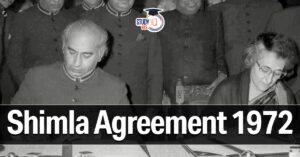Table of Contents
Operation Jericho: In the annals of India’s modern history, Operation Jericho stands as a testament to the resilience and strategic prowess of the Indian Air Force. This significant military operation played a pivotal role in quelling the rebellion in Mizoram during the late 1960s and early 1970s. It was a time of unrest, with the region in turmoil, demanding a swift and strategic response.
Operation Jericho Background
Mizoram, nestled in the northeastern part of India, had been marred by insurgency and separatist movements for years. The Mizo National Front (MNF), led by Laldenga, was at the forefront of the secessionist movement, demanding an independent state of Mizoram. The region had become a hotbed of insurgency, leading to significant unrest and challenges for the Indian government.
Operation Jericho Timeline
- Pre-1966: Mizoram was part of Assam, and the Mizos had long-standing grievances regarding their political and economic marginalization.
- March 1, 1966: The Mizo National Famine Front (MNFF) was formed under the leadership of Laldenga. It was initially focused on addressing the severe famine that had struck the region.
- April 29, 1966: The MNFF transformed into the Mizo National Front (MNF) under Laldenga’s leadership. Its objective shifted from famine relief to achieving Mizo self-determination and secession from India.
- February 28, 1967: The MNF carried out its first armed attack against Indian security forces, marking the beginning of the insurgency.
- March 1, 1967: The Government of India responded by launching a military operation called “Operation Jericho” to suppress the insurgency. Violent clashes between MNF insurgents and Indian security forces continued during this period, leading to casualties on both sides.
- June 30, 1971: Laldenga was captured by the Indian authorities, dealing a significant blow to the MNF leadership.
- 1972: A peace accord known as the “Mizoram Accord” was signed between the Government of India and the MNF. As per the accord, Mizoram was granted statehood on February 20, 1987, and the MNF agreed to lay down arms and participate in the democratic process.
- 1987: Mizoram became a full-fledged state of India on February 20, 1987.
- Post-1987: Mizoram has since been a peaceful state, with the MNF becoming a legitimate political party and participating in state elections
Genesis of Operation Jericho
In 1966, the Mizo National Front (MNF) separatist movement was gaining significant momentum in what was then known as the Mizo Hills. To counter this, the Indian government had made the decision to deploy an additional Assam Rifles battalion to the region, in addition to the one already stationed there, along with a few Border Security Force (BSF) companies.
In response to this deployment, the leadership of the MNF devised a bold plan known as ‘Operation Jericho.’ Their objective was to seize control of Aizawl, the largest town in the area, and ultimately, the entire Mizo Hills. It was named after the biblical story of Jericho, a city whose walls fell after the Israelites’ long, strategic siege.
Remarkably, Operation Jericho was executed with remarkable precision. It was characterized by meticulous military preparation and strategy, described by military experts as a “masterstroke.” This level of readiness and execution had not been witnessed before in the Indian subcontinent. As a result, the MNF swiftly overran Aizawl, achieving their objectives in just a matter of days.
Operation Jericho & Government’s Response
Under the leadership of Brigadier Rustom Zal Kabraji, ground operations were initiated to reclaim rebel-held positions. Kabraji commanded the 61 Mountain Brigade, stationed in Agartala, and spearheaded these efforts. Despite attempts to resupply the Assam Rifles battalion through helicopter missions, the tenacious rebel opposition resulted in the downing of several supply flights. The ground operations encountered substantial resistance, necessitating several days of intense engagement before reaching the city of Aizawl.
Operation Jericho and Indian Air Force
The Indian Air Force (IAF) played a central role in Operation Jericho. Amidst the Army’s persistent struggle to dislodge rebel forces, the Indian Air Force (IAF) was summoned into action. Initially, the IAF’s primary objective was to facilitate the resupply of army installations, a task entrusted to Dakotas and Caribou transport aircraft, which were promptly mobilized from Guwahati and Jorhat.
In a daring mission that would change the course of events, a Dakota aircraft endured a staggering 21 bullet holes but managed to execute a remarkable landing at Kumbhigram air base near Silchar. This critical incident marked the turning point that prompted offensive air operations.
Strategic Airstrikes
One of the key components of Operation Jericho was the targeted airstrikes against MNF strongholds. These precision attacks disrupted the insurgents’ ability to regroup and fortified the government’s position. The IAF used its fighter jets and transport aircraft effectively in these operations.
Troop Movement and Resupply
The IAF’s involvement extended beyond just airstrikes. It facilitated the rapid movement of troops and supplies to remote areas of Mizoram, where the rebellion was most active. This not only bolstered the government’s presence but also demonstrated the reach and flexibility of air power in counterinsurgency operations.
Operation Jericho: Aftermath and Resolution
Following a successful combination of ground and aerial operations, Brigadier Kabraji’s Brigade effectively restored order within Mizoram. Mizoram, akin to other northeastern states, was originally a part of Assam. In 1971, this area was designated as a Union Territory (UT) and subsequently gained official status as the UT of Mizoram in 1972.
The turning point came with the Mizoram Peace Accord of 1986, a pivotal agreement reached between the government and the MNF (Mizo National Front), which laid the groundwork for consequential constitutional changes.
A significant milestone was reached with the Indian Parliament’s 53rd amendment in 1986, which facilitated the establishment of Mizoram as India’s 23rd state. This transformation marked the evolution of a region that had once been embroiled in insurgency into a peaceful and officially recognized state within the Indian Union.
Operation Jericho UPSC
Operation Jericho stands as a remarkable chapter in India’s history, showcasing the indomitable spirit of the Indian Air Force and the nation’s commitment to preserving its unity. This operation, initiated during a tumultuous period in Mizoram’s history, witnessed the MNF’s audacious insurgency and the swift, calculated response by the Indian government. The coordinated efforts of ground forces and the Indian Air Force, marked by daring air missions and precision airstrikes, led to the restoration of peace in Mizoram. Subsequent constitutional changes and the Mizoram Peace Accord paved the way for the region’s transformation into a peaceful and recognized Indian state, marking a triumph over insurgency and a beacon of hope for lasting peace.


 Shimla Agreement 1972 to 2025: From Peac...
Shimla Agreement 1972 to 2025: From Peac...
 UPSC Marks 2025 Out – Download PDF and...
UPSC Marks 2025 Out – Download PDF and...
 Best Optional Subject for UPSC, Check Sc...
Best Optional Subject for UPSC, Check Sc...





















